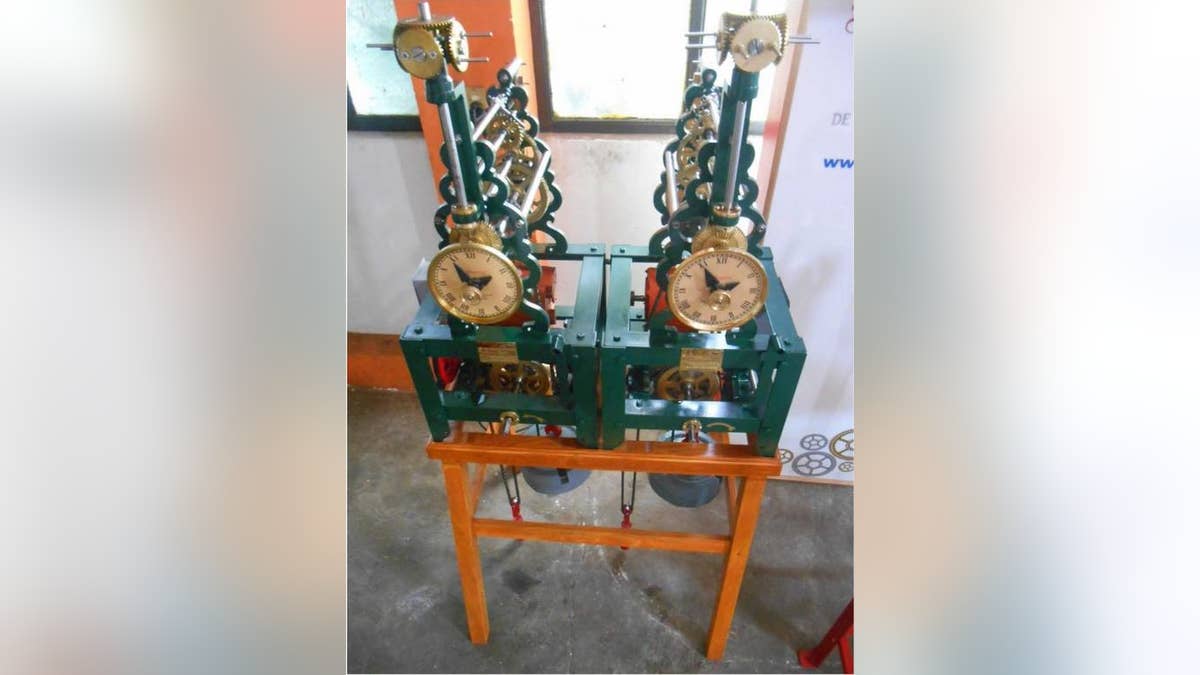
Pendulum clocks made by Mexican clock manufacturer Relojes Centenario were used to investigate the mechanisms behind synchronization. (Relojes Centenario)
The 350-year-old mystery of why pendulum clocks hanging from the same wall can influence each other and synchronize over time may hold even more secrets than previously thought, researchers say.
Solving this mystery could shed light on puzzling aspects of a variety of synchronized behaviors, such as how brain cells work together, the scientists added.
In 1665, the inventor of the pendulum clock, Dutch physicist Christiaan Huygens, was lying in bed sick, watching two of his clocks, when he noticed something odd: No matter how the pendulums on these clocks started, they ended up swinging in exactly the opposite direction from each other within about a half-hour. [The 9 Biggest Unsolved Mysteries in Physics]
For centuries, the cause of this effect was unknown. Solving the puzzle could help shed light on the mysterious phenomenon of synchronization, scientists say.
"The synchronization phenomenon is one of the most pervasive drives in nature," said study lead author Jonatan Peña Ramirez, a dynamicist at the Center for Scientific Research and Higher Education in Ensenada, Mexico. "For example, consider a couple dancing to the rhythm of music, or violinists in an orchestra playing in unison, or a school of fish gracefully swimming."
In a separate study published last year in the journal Scientific Reports, scientists suggested that the explanation for this phenomenon involved sound pulses traveling from clock to clock — for instance, through the wall on which the machines hang. However, Peña and his colleagues now suggest that Huygens' original explanation for this mystery could be the correct one.
The researchers experimented with two complex pendulum clocks known as monumental clocks."To the best of our knowledge, this is the first time that Huygens' experiment is reproduced using real monumental pendulum clocks," Peña told Live Science. "Previous studies have used scaled-down versions of pendulum clocks, or commercial and generic clocks."
The scientists placed both clocks on the same wooden table. As they expected, the motion of the clock pendulums synchronized over time.
However, unlike the clocks in Huygens' experiment, the clocks did not swing in opposite directions. Rather, they unexpectedly moved in exactly the same direction. Moreover, while the clocks stayed in sync, they became slower and more inaccurate over time, the scientists said.
To explain these findings, the researchers developed a mathematical model of the clocks, taking into account the flexible nature of the wooden support that both machines rested on. The model suggested that the clocks could make the wooden board vibrate.
The researchers found that the support connecting the clocks (in this case, the wooden table) could serve as a kind of communication channel between the clocks, which they could use to exchange energy. The rigidity, thickness and mass of this support can influence the way in which the clocks synchronize and how inaccurate they become, the researchers said. [5 of the Most Precise Clocks Ever Made]
Long ago, Huygens suggested that the synchronous behavior of the clocks he observed might be caused by "the imperceptible vibrations of the beam on which they are hanging," Peña said. Huygens "was so brilliant that he gave the correct explanation for his discovery without using a single equation."
These findings suggest that much remains unknown about how coupled pendulum clocks behave, Peña said. "There still are hidden secrets to be revealed, and consequently, further studies of this system are necessary in order to unveil more details about the complex yet intriguing synchronization phenomenon," Peña said.
A better understanding of synchronization could have technological and biological implications. For instance, consider two rotors mounted on an elastic support. "A familiar example of this kind of devices is a washing machine," Peña said. Under certain conditions, the rotors may synchronize to rotate in the same direction, or in opposite directions, he said.
The synchronization of these rotors in opposite directions is highly desirable, because this will reduce or even eliminate the vibrations of the washing machine while its rotors are operating, Peña said. However, synchronization of these rotors in the same direction is not desired at all, because strong vibrations can result, with harmful and undesirable effects, he explained.
"Something similar happens in living organisms," Peña said. "For instance, inside the human body, there are several biological rhythms — respiration, heartbeat and blood perfusion, just to mention a few of them. It has been found that when some of these rhythms synchronize with each other, the energy consumption is minimal; hence, in this case, the onset of synchronization is beneficial. On the other hand, synchronization can also be dangerous or detrimental; it is widely accepted that the process of seizure generation is closely associated with abnormal synchronization of neurons."
The scientists detailed their findings online March 29 in the journal Scientific Reports. The clocks used in the experiments are now in a museum next to monumental clocks factory Relojes Centenario in Zacatlán, Mexico, where the clocks were made.
- The Mysterious Physics of 7 Everyday Things
- Twisted Physics: 7 Mind-Blowing Findings
- Top 10 Inventions that Changed the World
Copyright 2016 LiveScience, a Purch company. All rights reserved. This material may not be published, broadcast, rewritten or redistributed.
